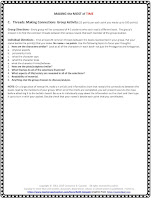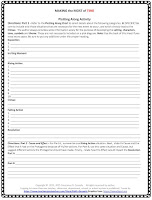With an individual novel study, teachers can guarantee that they are offering calm learning oases that will keep students on task as well as wanting to learn. This plan also requires them to be responsible for their assigned work. Best of all, it leaves the chaos out in the hall behind the closed classroom door.
Literary Analysis-MAKING the MOST of TIME succeeds during those weeks when classes meet fewer times or have a number of scheduled interruptions to learning, such as extended testing periods. It is perfect for May because each day, many students may be absent due to testing, making teaching to the whole group difficult. In my district, the country-wide A.P. exams take up the first two weeks of May. On the day following the last exam, the state's Standards of Learning exams begin. They last until the end of the month and are followed by make-up days, which are crucial for seniors need another chance to pass, a graduation requirement. Teaching becomes catch as catch can for five weeks, creating stress for teachers and students. MAKING the MOST OF TIME keeps students on the Learning Train.
Here are a few suggestions that expand on the How to teach part of the Teacher Notes, the first page after the product cover. The Who, What, When, Where are self-explanatory. Teachers can read them and adjust the goals to their students' skills and abilities.
1. Hand out these packets a week or so before the testing schedule starts. Not only will this give students the opportunity to choose the book they want to read for this project, and to start reading, but also it allows teachers time to ensure that every student understands the criteria, requirements and time table for this project before they start missing class because of scheduled tests.
2. Explain the parameters for the required books. My first requirement is that they be novels or narrative nonfiction, like Into the Wild by Jon Krakauer. No How-To books, biographies, autobiographies, series of essays, memoirs or collection of poems are allowed. Also, I set a minimum length of around 200 pages. Zora Neale Hurston's, Their Eyes Were Watching God is required for seniors and it's 184 ,pages, so I set the minimum page limit around there.
3. To keep the choices simple, for a class of 25 students, I select four each of 7-8 novels from the school's book room that I would love the kids to read but didn't have a chance to teach during the year. To not infringe on my colleagues' literary territories and their grade levels, though, I keep to the level(s) that I am teaching that year- freshman, sophomores, juniors, seniors. I limit my selection to four of each title as I didn't want more than than that number of students to read the same novel.
4. If any of the students are truly apathetic about the choices, teachers may allow them to choose the novel they would rather read, with parental permission, of course. Although I really try to enthuse students about those that I chose, my main objective is to try to turn those students I haven't reached, yet into literature lovers. As James Patterson said,

5. The last four bullet points under this section of the Teacher Notes depend on each teacher's school testing calendar, how many of the assignments in this packet teachers want to include, and the skills and abilities of their students as well as the responsibility for independent work their students practice..
These next few images reveal the student directions, the first pages of the various activities and the project rubric.
Pages 3, 4 and 5 detail the directions. It works well if teachers read these aloud while students follow, pausing for questions, answers, clarification when necessary.
Page 6 is where students jot down the notes they took while reading.
Page 12 is for the Theme segment of this project.
Page 13 is the all-important Grading Rubric.
The key element to the beauty of this unit is that students create their schedules for completing the work after the teacher sets the Due Date. The May calendar that each teacher hands out to the class should show that every day the class will either read for half of the period, or work on the packets for half of the period. The other half of the period the whole class will either work on a facet of writing or will be divided into groups to discuss various aspects of the chosen novels. For the latter activity, the groups should be comprised of students who have each read a different novel. suggestion: change the groups every day so students encounter a wide range of viewpoints and analytic thought.
Each student designs his/her own schedule for the first half of the period, showing whether he/she will be reading or working on packet assignments. Teachers choose the second half of the period activity, depending on how many students are present that day, and how many are absent due to testing.
By managing their class time wisely, students will only have to complete the typing and compilation of the required activities at home right before the final packets are due. They should bind all of the components of their packet together in some way - a folder with pockets is best.
Teaching time won’t be interrupted and chaotic because of testing, when this unit plan becomes students' May learning keystone. Its effectiveness stems from dual factors - students hold the ownership for what they are learning and when they are learning.
More details to aid you as you make May bloom with reading, writing and thinking are included in the course description or this unit. https://www.teacherspayteachers.com/Product/Literary-Analysis-MAKING-the-MOST-of-TIME-681650. ($)
And you, my teacher friends, will appreciate the fact that your students are challenging themselves intellectually with these substantive activities as they increase their reading comprehension, and their higher level thinking and writing skills with and no loss of learning continuity.
Enjoy a Teach It Now Day Every May Day,













No comments:
Post a Comment